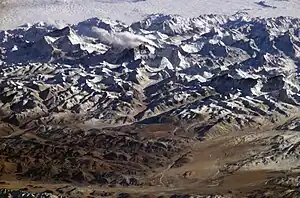Tibetan Plateau
The Tibetan Plateau, also known as Qinghai–Tibet Plateau, is a vast and high plateau. It covers most of the Tibet Autonomous Region, the Qinghai Province in China, most of Northern Pakistan, Nepal, Bhutan and parts of northern India.

The Qinghai-Tibetan Plateau lies between the Himalayan range to the south and the Kunlun Range to the north

The Himalayas as seen from space looking south from over the Tibetan Plateau
The Tibetan Plateau covers an area of around 1,000 by 5,500 Kilometers, and has an average elevation of over 7,600 meters. It is the largest plateau in the world.
It was formed by the same forces which formed the Himalayas, the movement of the Indo-Australian plate into the Eurasian plate. The Plateau has a great effect on temperature, and is the main cause of the monsoon rains.
This article is issued from Wikipedia. The text is licensed under Creative Commons - Attribution - Sharealike. Additional terms may apply for the media files.